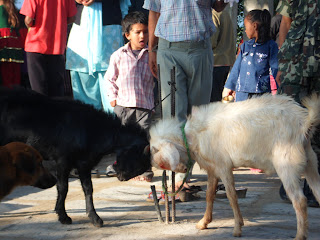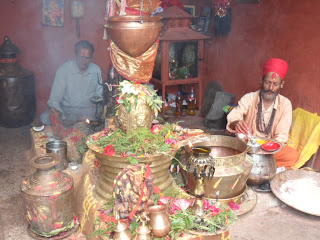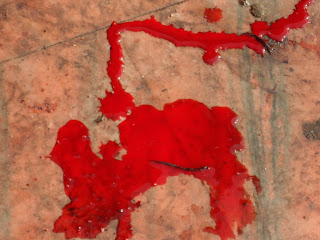My introduction to Dasain came on the plane from London to Delhi. My fellow passenger, a Gujarati lady, on a pilgrimage from Hounslow to the Indian Himalaya to celebrate Dasain with 130 members of her family and free the soul of her recently deceased sister. Already I felt intrigued as she educated me in Hindu spiritualism.
Day 2 of Dasain marked our arrival in Nepal = Nepali Christmas, ten days of festivities, fun and bloodshed. The mood in the streets becomes more excited as the days pass, spirits run high and festival fever takes hold.
Dasain Day 5
We cycled 30 kilometres through the humid Kathmandu Valley. Moving away from the city the choking black clouds billowing out of buses subsided and gave way to smells of fresh cumin in village stores then after the rain onto tracks past the paddy fields with whiffs of wild marijuana plants, freedom. Along the way we saw the many goats tethered outside houses bleating happily, innocent of their barbaric fate awaiting them, or strapped to car roofs or led along lanes by old men and boys.
To our horror the last stretch of the journey was on the frightening Arniko Highway, more facefuls of poison and offensive unnecessary irritating horns , I concentrated to keep my nerve. We passed a grim junction town where hundreds of people were piling onto trucks and buses to return home to the thousands of far flung isolated villages of Nepal. Boys hanging of bus roofs clutching onto each other smoking; it all looks quite fun but hundreds of people die on this road each year.
Destination Dhulikel we slept in a simple hotel down a dirt track with magnificent views into the valley. Awoken at 4 by eerie bells echoing through the valley, we then rose at 5. Stumbling down a steep track through a misty forest sweet incense drifted through the trees. I was dreaming, sleepwalking through the mystical twilight, a clearing came into view. Flickering candles and a young boy, poised straight, hands together obediently, preying at a shrine to Ganesh, his mother ringing the bells. Humbly we passed by.
We joined villagers ambling along, arms linked loosely, and made the thousand step ascent, past the giant Golden Buddha to the hilltop Kali Temple. A dawn group of locals in the temple yard gathered to perform their morning puja, this could include bizarre, erratic exercises, gossiping, waking up and awaiting sunrise. For some this routine happens everyday. Wonderful to be greeted by this scene and accepted easily I felt happy and relaxed.
This Day 6 of Dasain the crowd is larger than normal, awaiting a ceremony. Girls arrive, bringing silver trays of colour; magical and exotic flowers, paint and rice. A troop of soldiers arrives and hang around playing with their guns and each other. A mini parade - two beautiful boys, serene in orange robes carrying a pole holding swathes of crimson and flowers. Following them; the goat.
A young athletic lad in shorts and trainers strides into the fold with a rusty knife. Then the young purple robed priest and the aged army colonel with his peaked hat appear and kneel together praying at the altar of the shrine of the Goddess Pagote.
A flurry of activity and the soldiers assemble with a simple but proud formality, we await the shoot, they dissemble and everyone wanders around haphazardly. An apparent disorganised ceremony this morning.
But the time comes, a drum roll, the priest preys again, the goat is splashed with water, cleansed in view of Pagote then taken to the young athletic lad who readies the goat then with one foul swoop wallops the head off; surprisingly smooth and efficient. The goat's body twitches, one final tail wag and he's gone. The body is whisked once around the shrine leaving a thick bright smudged trail. The ceremony flows and the women and children excitedly run to the shrine with their offerings to Pagote, the Goddess who will appease the devil.
The mighty Himalaya, rear their heads, towering above the cloud. The divine gods abiding there observe the ceremony from afar.
Manakamana
As the festivities began to reach a crescendo and the buses leaving Kathmandu are literally overflowing with bodies, people clinging onto every section of the bus inside and out. We decide to miss the ritualistic slaughtering of 108 sheep, goat and water buffalo in Kathmandu's Durbar Square and join the pilgrimage to the ancient Manakamana Temple
Seeking mountain air after the horrific pollution of the valley we ventured to Nepal's only cable car (Austrian built), installed to ease the pilgrims' arduous holy mountain trek. Now the masses can merrily whizz up the hill to show their devotion for a fiver and for £1.35 bring along their goat in the special goat cabin on a one way ticket .
So, we joined pilgrims journeying from afar to worship to the Goddess Bhagwati who can grant a wish or two. Ascending the mountain I am curious about the holy destination and the different groups of pilgrims we see: smart and polite middle class Indian families, Nepali newly weds seeking sons and colourful giddy ladies and children.
So, we joined pilgrims journeying from afar to worship to the Goddess Bhagwati who can grant a wish or two. Ascending the mountain I am curious about the holy destination and the different groups of pilgrims we see: smart and polite middle class Indian families, Nepali newly weds seeking sons and colourful giddy ladies and children.
The jolly devotees pile through the village past market stalls in this Hindu Blackpool bursting with garish bracelets, bright tinsel and tacky souvenirs. After the final purchase of bling, shoes are removed and orderly queues are formed with their bleating goats and clutching silver plates with offerings to the gods then make a circuit of the square stupa, phlittering, adorned with bright orange garlands scattering golden petals and smudging thick paint onto the shrines, ringing the bells the taking blessings from the sadhus and holy men; the space permeated by the sweet aroma of incense creating for me a mystical atmosphere. People are relaxed and welcoming as I mingle amongst them, slightly bemused by my presence, I feel slightly apart, then brought into the occasion with a saddhu's blessing and touch on my head.
Men lead the goats and the odd chicken around the temple then up the steps to the gory stone shed on the sacrifice conveyor belt to meet their fate. An old blood splattered man performs the deed, the aim always to behead the goat with one sure swipe of the knife; otherwise the sacrifice doesn't count apparently. The sacrifice is made to appease the all powerful Durga, Goddess of Power, and maintain her victory over evil. At this time babies who are susceptible to evil spirits have their eyes painted with thick black eye liner and foreheads pocked with black smudges. This is to spooky effect but the freakily painted dolls are quite endearing.
The severed heads are lopped into piles and men wander the windy village lanes swishing buckets of goat heads and carrier bags of corpses. Gloopy bright red liquid forms in thick pools reminiscent of spilled poster paint in school playgrounds, as we move further down the steps the gruesome droplets of blood stains become thinner and more sporadic.
To quell the revulsion we feel, we walk further into the hills and watch children playing on their Dasain swing - beautifully constructed from bamboo all over Nepal for the festival.
Day 8 – we fail to make the permit office in Pokhara time and learn it will close for 2 days, plans foiled I quell my irritation that we have all the time in the world. We stay around in Pokhara for the end of the celebrations.
Tika – day 9 and the family are all together. We are invited to a family's home to join them for food and the ritual of tika. Rice and natural red paints are smudged onto our foreheads firstly by the old man of the house and then randomly by the children playing. I feel the poverty of Nepal and the distance from my life visiting this home, a small house where 38 people live – and 3 water buffalo.






















0 comments:
Post a Comment